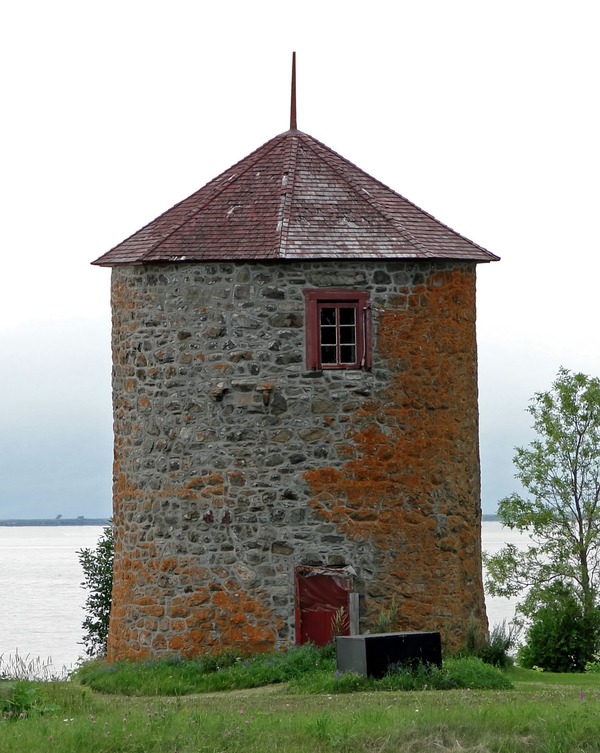
Source: Courtesy of Wikimedia Commons
AMIOT (Amyot) DE VINCELOTTE, CHARLES-JOSEPH, navigator, naval lieutenant, militia commander, seigneur; b. 23 March 1665 at Quebec, son of Charles Amiot* and Geneviève de Chavigny; buried 9 May 1735 in the same town.
Charles-Joseph received his elementary education at the Jesuit college in Quebec; then he studied the principles of navigation, doubtless under the direction of Martin Boutet*. In 1680 he received from his mother the fief of Vincelotte (Cap Saint-Ignace) that she herself had received in 1672 from Talon*. At 19, in 1684, he enlisted in the militia. He drew up a will the same year, before leaving “to travel and go to war in the king’s service against the Iroquois. “We find him again in 1693 when he presented a petition – successfully – to Louis de Buade* de Frontenac and Bochart de Champigny asking that his fief be enlarged; he wished, he wrote, to “contribute to the utmost of his ability to the development of this colony and work hard to establish himself there.”
When Governor Frontenac died in 1698, two of the colony’s officers, Rigaud de Vaudreuil and Callière, aspired to succeed him. Each wished to be the first to notify the court of the governor’s death and to seek the nomination. During the winter of 1698–99 Amiot was charged with this mission by Rigaud de Vaudreuil and Champigny, while Augustin Le Gardeur de Courtemanche was chosen for the same purpose by Callière. A race took place between the two emissaries, each wishing to be the first at court. Amiot de Vincelotte was the last to arrive, although only a few hours after Courtemanche, and Callière was granted the governor generalship.
In 1703 the seigneur Amiot was recommended for the post of attorney of the provost’s court of Quebec. He was described in a document as “the person in this country whom we know to be most capable of filling this position. He is active, is intelligent, and has applied himself to the study of the ordinances and of the customary law of Paris, which he knows well.” He did not obtain the post, which was entrusted to his step-father, Jean-Baptiste Couillard de Lespinay, who had married Geneviève de Chavigny in 1680. Perhaps this can be seen as one of the causes of the subsequent rivalry between Amiot and Couillard.
Amiot next carried out several expeditions in 1703–4 to the shores of Newfoundland, under the command of the privateer Jean Léger de La Grange and of Claude Pauperet. In 1706 he was chosen to go privateering off the shores of New England, serving as a lieutenant under Louis Denys* de La Ronde. In particular, they both fought a hard battle against John March, who laid siege to Port-Royal on 26 May 1707 (6 June n.s.). After their victory over the English they carried the good news to the king, and took advantage of the opportunity to ask for help for an expedition against Boston. The French government approved the project, but was unable to give them any other ship except the Vénus, a rather poorly equipped frigate; they nevertheless sailed it for two years, and made numerous captures. Did Amiot subsequently take part in other military enterprises? We do not know. The last mention of his activity in this field is in 1727 when he was appointed commander of the militia forces on the south shore of the St Lawrence. We know, however, that in 1718 he sought, apparently in vain, a commission as ensign and the position of lieutenant of the port of Quebec.
Did Amiot de Vincelotte have a particular liking for wrangling and rivalry? It may be thought so. In any case he spent much of the money that came from his privateering and his seigneury on long and useless legal actions. In 1724, after his mother’s death, Amiot brought several lawsuits against his step-father; “he boasted that he had some 15 lawsuits to bring [against him].” He even claimed from him “six spoons, six forks and one silver cup.”
On 19 Feb. 1691, at Montreal, Charles Amiot de Vincelotte had married Marie-Gabrielle, daughter of Jean-Vincent Philippe de Hautmesnil. Thirteen children were born of this marriage. Nevertheless in 1727 he sought a separation.
After a full life, he died at the age of 70 at Quebec.
AJQ, Greffe de Gilles Rageot, 10 juillet 1684. AQ, NF, Coll. de pièces jud. et not., 580, 607; NF, Ord. des int., XII, 128f., NF, Registres d’intendance, I, 9. “Mémoire de Gédéon de Catalogne sur les plans des seigneuries et habitations des gouvernements de Québec, les Trois-Rivières et Montréal,” BRH, XXI (1915), 330 Ivanhoë Caron, “Le fief Cap Saint-Ignace,” BRH, XX (1914), 365–69. P.-G. Roy, “Charles-Joseph Amyot Vincelotte,” BRH, XXV (1919), 306–15.
Noël Bélanger, “AMIOT (Amyot) DE VINCELOTTE, CHARLES-JOSEPH,” in Dictionary of Canadian Biography, vol. 2, University of Toronto/Université Laval, 2003–, accessed November 28, 2024, http://www.biographi.ca/en/bio/amiot_de_vincelotte_charles_joseph_2E.html.
The citation above shows the format for footnotes and endnotes according to the Chicago manual of style (16th edition). Information to be used in other citation formats:
| Permalink: | http://www.biographi.ca/en/bio/amiot_de_vincelotte_charles_joseph_2E.html |
| Author of Article: | Noël Bélanger |
| Title of Article: | AMIOT (Amyot) DE VINCELOTTE, CHARLES-JOSEPH |
| Publication Name: | Dictionary of Canadian Biography, vol. 2 |
| Publisher: | University of Toronto/Université Laval |
| Year of publication: | 1969 |
| Year of revision: | 1982 |
| Access Date: | November 28, 2024 |